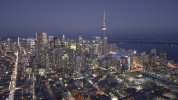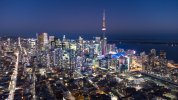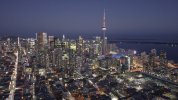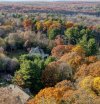What a fantastic picture! Where did you launch from? I'm near Toronto
@PaulDoneDrone Nice photo, and exactly the sort of side-by-side comparison I was looking for

. I might be missing something obvious, but to me the resized pictures look to have very similar levels of detail. The DNG has a good bit more contrast so the detail is easier to pick out. I had a very quick play with the JPG (below, for ridiculing and tearing to shreds ?) and sharpened it up a bit to tease out some of the detail and pushed the contrast a bit. The DNG definitely has the edge when it comes to noise, though - especially noticable in the darker areas in the bottom left.
Ultimately the point of my original post was not to claim that JPG is as good as RAW, or that RAW is a waste of time, rather to explore what the
actual benefits of RAW are rather than perceived, or ignorantly believed, "because a guy on youtube said it".
Fair enough, in one sentence: they can both made look good for Instagram, and I can make them look exactly the same jpg and DNG, color grading can be done on both the same way for Instagram. IG butchers literally every photo, it is not service for photographers to display their work if full.
The difference is substantial when looking at the photo on a big screen or in print.
It all depends on who is your audience and you planning to consume content, if work is designed for smartphones, jpegs are fine. If you are planning to get the most out of it DNG is the way.
Another example: A friend of my just spend 1500$ on headphones because he claims there are delivering incredible sound, I can't tell the difference between them and my stock iPhone headphones, and my Bose noise-canceling headphones to me sound 10 times better. He says I'm an ignorant deaf prick, my wife says the same for other reasons. I believe them both, but I will not buy $1500 headphones.
When I take photos for an Instagram update on my personal account or photos I send via emails to my friends etc. I always use jpeg, when I'm going for that Citykillerz shoot I always use DNG.
no right, or wrong, right tools for the job.
Most YT channels are paid gigs that have nothing to do with the product, it is a new way of advertising. 20y ago people watched TV and consumed adds on TV, now it all transitioned to YT. When you watch that guy with 900k followers and he is reviewing
MM2 on the first day after release, this is a smart advertisement that looks like real usage/life, etc but in reality, it is garbage useless add. Not a single YT reviewer that post a video on day one said anything interesting because they were told what to say, they didn't lie, it is an awesome product but they didn't say anything that is not on DJI website, they all said the same in the different way to target as many people as possible.
10 y from now or probably less, once people will clue in nobody will watch YT the same as you don't watch TV adds anymore.
DNG contains uncompressed raw sensor data, it has way more info than JPEG and that's about it, it is not better or worst it has more data.






 . I might be missing something obvious, but to me the resized pictures look to have very similar levels of detail. The DNG has a good bit more contrast so the detail is easier to pick out. I had a very quick play with the JPG (below, for ridiculing and tearing to shreds ?) and sharpened it up a bit to tease out some of the detail and pushed the contrast a bit. The DNG definitely has the edge when it comes to noise, though - especially noticable in the darker areas in the bottom left.
. I might be missing something obvious, but to me the resized pictures look to have very similar levels of detail. The DNG has a good bit more contrast so the detail is easier to pick out. I had a very quick play with the JPG (below, for ridiculing and tearing to shreds ?) and sharpened it up a bit to tease out some of the detail and pushed the contrast a bit. The DNG definitely has the edge when it comes to noise, though - especially noticable in the darker areas in the bottom left.








